 |
 |
 |
 |
|
 |
 |
 |
|
|
| Type: Kwik, Year: 1938, Built: 1 piece
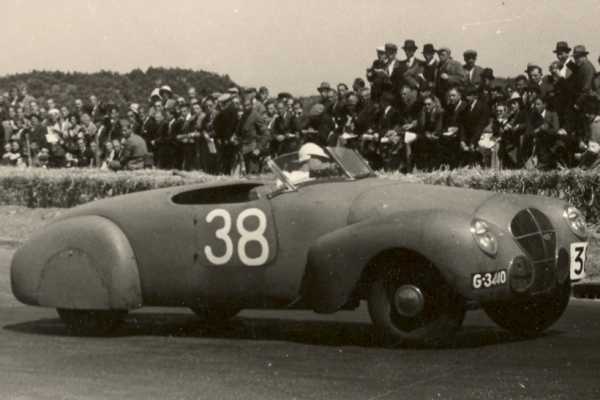 Forerunner
of the postwar Gatford and Gatso sportscar. Two-seater, with luxurious
red Connolly leather interior. Detachable fabric top. Bodywork custom-built
to Maurice Gatsonides' requirements by Schutter & Van Bakel, Amsterdam. Forerunner
of the postwar Gatford and Gatso sportscar. Two-seater, with luxurious
red Connolly leather interior. Detachable fabric top. Bodywork custom-built
to Maurice Gatsonides' requirements by Schutter & Van Bakel, Amsterdam.
Built on the first Ford Mercury chassis imported into Holland, and
therefore featured the enlarged, 3.9 litre 95 b.h.p. V8 engine fitted with
high-compression aluminium cylinderheads and two double barrel carburettors.
The engine was exclusive to the Mercury line, rather than the regular
3.6 litre 85 b.h.p. Ford V8.
With only the "Kwik" (the Dutch word for "mercury") legend on the body
being visible here it is the typical Ford-pattern road wheels which give
a clue to the car's mechanical specification.
Making its debut in the Prize
of Zandvoort 1939 with number 38, a cylinderhead-gasket problem and
engine damage from the resultant overheating caused Gatsonides to pull
out of the race before the end.
Contested the Liège-Rome- Liège Rally in 1939 with number
28. Team : Maurice Gatsonides - Lex Beels. Finished in 14th place.
Early 1940 Kwik collided with a truck and a streetcar (tram) in the
Dutch village of Lisse.
Repaired, it was sold soon afterwards, and has subsequently disappeared......
At the end of 2003 Tom Gatsonides, the son of Maurice, became the new
proud owner of "Kwik". The car was a present from the staff of Gatsometer
BV the company Maurice started in the late 50's.
Contested the Winter
Trial in februari 2005 with number 10. Team : Tom Gatsonides - Rosalie
Gatsonides.
|
|
| Type: Gatford (Gatsonides-Ford), Year: 1946,
Built: 1 piece
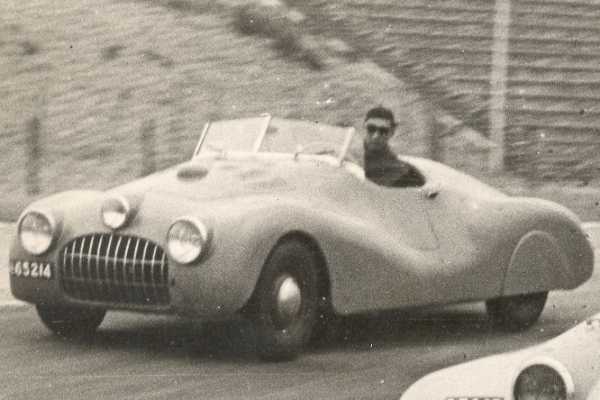 Built
on the chassis of the Ford V8 Roadster in which Maurice Gatsonides and
Klaas Barendregt had completed the 1938 Liège-Rome- Liège
Rally in 2nd position overall and winner of the unmodified category. The
chassis was suitably modified to reduce height. Built
on the chassis of the Ford V8 Roadster in which Maurice Gatsonides and
Klaas Barendregt had completed the 1938 Liège-Rome- Liège
Rally in 2nd position overall and winner of the unmodified category. The
chassis was suitably modified to reduce height.
The standard Roadster's 3.6 litre V8 S.V. engine was retained at first,
but replaced by the larger Ford Mercury 4 litre V8 soon after completion.
The same type used in subsequent Gatsonides-built cars. For the Gatford
the Mercury engine's power output was raised from the normal 95 b.h.p.
to a figure of 124. This was achieved principally by using a pair of American
tuning expert Eddy Edmunds' dual carburettors manifold and ribbed aluminium
cylinder heads. Of more efficient design, these raised the compression
ratio from the normal 6.8 : 1 to 7.5 : 1.
Transmitting the power to the rear wheels was the old Ford Roadster's
normal three-speed gearbox and a Columbia two-speed rear-axle assembly.
Thus, the Gatford had the benefit of six forward speeds. Overall the Gatford
could be considered as a Gatso modified Ford.
Perhaps the most striking feature however was the third head-light
placed centrally above the radiator grille. This had come about due to
the need for an extremely low bonnet line at the front of the car, whilst
further back needing to clear the carburettors mounted in the V of the
V8 engine.
Finished in second place overall on the first postwar staging of the
Alpine Rally, July 1946. Team : Maurice Gatsonides - Henk Blijdenstein.
Finished in third place in the Lisbon Rally 1947. Team : Maurice Gatsonides
- Theo van Ellinkhuizen.
Finished first on the first, postwar, Dutch sportscar race at the Leeuwarden
air force base, July 1947. Driver : Maurice Gatsonides.
This car was the only one to carry the "Gatford" name script, as the
Ford Motor Company felt it sounded too much like "Matford" (the abbreviation
of Mathis-Ford), which was Ford's brandname in France. Consequently the
remainder of the Heemstede-produced cars bore the name "Gatso" which was
of course every bit as appropriate, although, ironically, those later cars
were actually built on genuine but lowered Matford "13" (Ford France) chassis
with 4" shorter wheelbase than the American one. |
Gatford
|
SPORTS AND COMPETITION CARS
|
The GATFORD is a fast, comfortable and
above all a reliable Sportscar, designed to be driven for a long time at
high average speeds.
By means of a dual ratio back axle the revolutions of the engine
can be kept quite low, which improves its durability considerably while
a low petrol consumption is obtained.
The car itself is chiefly built from Ford parts, which are obtainable
everywhere at reasonable cost.
The very light body is built of duraluminium attached to a rigid
steel frame. As a result of years of experience gained in all kinds of
international competitions, a very good roadholding has been obtained,
coupled with remarkable good steering.
The driving qualities are only equalled by those of a few high priced
European cars.
SPECIFICATIONS
|
| Engine : |
120 b.h.p. at 4000 r.p.m. V8 monobloc.
Side valves. Aluminium high-compression heads with polished combustion
chambers. Two down-draught twin-choke carburettors. Special intake manifold,
highly polished. Steel backed main and connecting rod bearings. Full flow
oil filter and cooler. Special design camshaft. Bore and stroke 3.187 x
3.75 ins (80.95 x 95.25 mm). Cubic capacity : 239 cub. ins (3917 cc).
V8, O.H.V. engine of 175 b.h.p. at 5200 r.p.m. available at extra cost. |
| Cooling system : |
Pressure radiator. Two waterpumps
and a crankshaft-mounted fan. |
| Ignition : |
Scintilla Vertex magneto. Lodge
H.N.P. 14 mm. plugs. |
| Clutch : |
Single dry plate. |
| Gear ratios : |
top |
1 : 1 |
synchromesh |
|
| |
second |
1.8 : 1 |
synchromesh |
|
| |
first |
3.2 : 1 |
|
|
| |
reverse |
4.0 : 1 |
|
|
| Remote control central gear lever
or fitted to the steering column optional. |
| Back axle ratios available :
4.55 : 1, 4.44 :1, 4.33 : 1, 4.11 : 1, 3.78 : 1 and 3.54 : 1. |
| Overdrive of 28.5 % in back axle. |
| Suspension : |
Transverse leaf springs (front
and rear) with "Silentbloc" bushes. Anti-roll bar and double acting hydraulic
shockabsorbers in front. Hydraulic stabiliser with double acting shockabsorbers
at rear. |
| Brakes : |
Girling Hydro-Mech. |
| Steering : |
Left or right hand optional. Two-spoke
17" (455 mm) diam. steeringwheel. |
| Wheels : |
5 Easy-clean steel discs. Second
spare wheel complete with tire at extra cost. |
| Tires : |
6.00 x 16, 6-ply. |
| Petrol Tank : |
At rear, 20 Imp. gallons (90 L)
capacity. Two spare tanks, contents 7 Imp. gallons (30 L) each, mounted
in centre, alongside chassismembers, at extra cost. |
| Electrical equipment : |
6 Volt air ventilated dynamo. Constant
voltage control. 100 Amp. hrs. battery. Two powerful broad-beam headlamps
and one long-beam centre lamp. Rheostatic controlled instrument lights. |
| Dimensions : |
Wheelbase |
: |
108¼ ins (2.75 m). |
|
| Track, front |
: |
56 ins (1.42 m). |
|
| Track, rear |
: |
58 ins (1.47 m). |
|
| Overall length |
: |
171 ins (4.35 m). |
|
| Overall width |
: |
66 ins (1.70 m). |
|
| Overall height |
: |
53 ins (1.35 m). |
"Sports Roadster" |
| : |
57 ins (1.45 m). |
"Aero Coupé" |
| Ground clearance |
: |
8 ins (0.20 m). |
|
| Turning circle |
: |
36 ft (5.47 m). |
|
| Weight |
: |
21.5 cwt (1100 kg). |
"Sports Roadster" |
| : |
23.5 cwt (1200 kg). |
"Aero Coupé" |
| Specifications and prices may have to be modified
without notice. |
| |
|
|
|
December 1947 |
|
| Type: Gatso 4000 Aero Coupé, Year: 1948,
Built: 1 piece
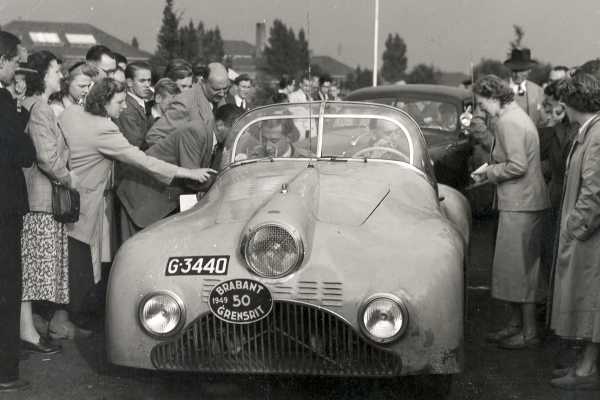 Built
on the Matford "13" chassis, lowered by five inches. 2+2 seater Built
on the Matford "13" chassis, lowered by five inches. 2+2 seater
A tuned 4 litre Mercury V8 engine providing the power. The general
styling echoed the original Gatford, but additionally the Aero Coupé
featured a sliding clear-plastic canopy reminiscent of a fighter aeroplane
and in fact manufactured for Gatsonides by the Fokker aircraft company.
Performance : over 100 mph (160km/h), Economy : better than 20 mpg.
Introduced at the Geneva "Salon de l'Auto" in march 1948 and also showed
at Holland's own first postwar RAI Motor Show in Amsterdam. From the United
States came orders for no less than 200 cars. But this was impossible for
Gatsonides, who hadn't really even the financial means with which to continue
his business at its modest level.
|
|
| Type: Gatso 4000 Roadster, Year: 1948, Built:
2 pieces
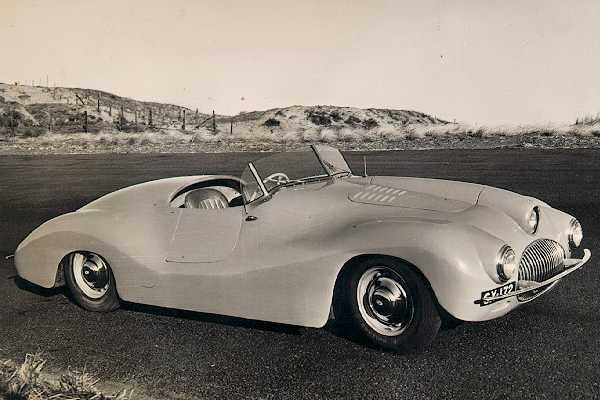 Open
two-seater, using the similar chassis and mechanical components as the
Aero Coupé (Matford "13" chassis, Mercury V8). Open
two-seater, using the similar chassis and mechanical components as the
Aero Coupé (Matford "13" chassis, Mercury V8).
A detachable cloth top with side screens was provided for weather protection.
1 sold (detail : righthand-side steeringwheel) to Félix Endrich
of Switzerland, Olympic champion two-men bobsleigh, 1948 Sankt Moritz.
With this car Endrich became Switzerland's mountain-climb champion. Later
in 1948 he was killed in a bob-sleigh accident.
What happened to the car ?
1 sold to Dutchman Aad Tops who emigrated to South-Africa. Tops drove
this car to victory in the Lorenzo Marquez Rally.
Last known owner (1990) : a doctor in Graaf-Reinet, South-Africa......
|
|
| Type: Gatso 4000 Coupé, Year: 1948, Built: 2 pieces
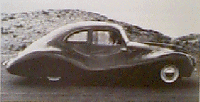 Fixed-head
coupé, using the similar chassis and mechanical components as the
Aero Coupé (Matford "13" chassis, Mercury V8). Almost identical
to the previous Roadsters. Fixed steel hardtops however rather than the
removable cloth tops of the earlier twoseaters resulted in these being
closed Coupés. Fixed-head
coupé, using the similar chassis and mechanical components as the
Aero Coupé (Matford "13" chassis, Mercury V8). Almost identical
to the previous Roadsters. Fixed steel hardtops however rather than the
removable cloth tops of the earlier twoseaters resulted in these being
closed Coupés.
Of these one was for Dr. Roberts, a doctor in Sneek (Friesland), whilst
the other car belonged to a Mrs. Jochems, a well-known personality in The
Hague's high society.
Dr Roberts sold his car ......
|
|
| Type: Gatso 4000 2+2 Coupé, Year: 1949 ?, Built: 1 piece
?
A low-built 2+2 fixed-head coupé, using the similar chassis and
mechanical components as the Aero Coupé (Matford "13" chassis, Mercury
V8).
This car was nicknamed "Molehill" due to the curvature of the protruding
top, was intended to win the tough 1950 Liège-Rome-Liège
rally. Co-driver : Ginet Trasenster (Belgium).
|
|
| Type: Platje, Year: 1949, Built: 1 piece
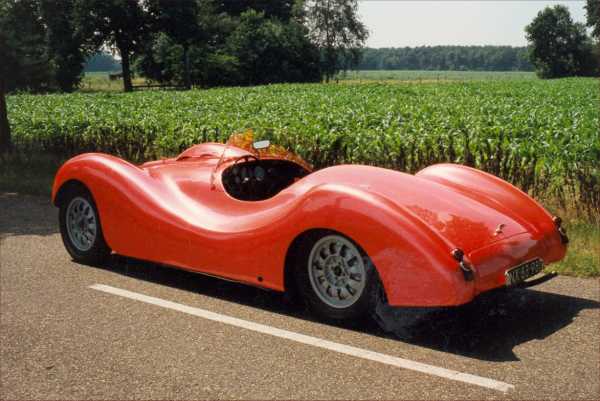 Fiat
1500 chassis (shortened), Fiat 1.5 litre six-cylinder in-line OHV engine,
Dubonnet independent front suspension, finned alloy brake drums. Fiat
1500 chassis (shortened), Fiat 1.5 litre six-cylinder in-line OHV engine,
Dubonnet independent front suspension, finned alloy brake drums.
This car didn't require the bonnet bulge of the Ford based Gatso's,
and so the central lamp was omited.
The car was nicknamed "Platje" = "Flatty".
Leading at the National Sportscar Races held at Zandvoort in 1950,
a rear wheelrim centre gave away, putting the car and its driver/constructor
out of the race. Flatty was equipped with ultra-lightweight wheels specially
made in France, which aided the performance of the car whilst also providing
better brake cooling. Unfortunately, the one on the left rear failed to
stand up to the high cornering forces generated on the Zandvoort circuit.
|
|
| Type: Gatso 4000 Luxe, Year: 1950, Built: 1 piece
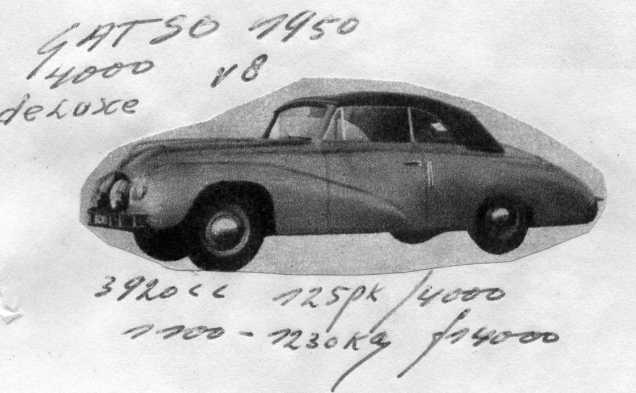 The
last and most luxurious Gatso. Built for a Dr. Polano, a well known personality
in the The Hague society scene, and was specially designed according to
the doctor's wishes. The
last and most luxurious Gatso. Built for a Dr. Polano, a well known personality
in the The Hague society scene, and was specially designed according to
the doctor's wishes.
On a modified and longer Ford Mercury chassis and running gear, and
with a normal Mercury V8 engine this car was however of more conventional
height, being built as a luxury six-seat convertible with a fully-retractable
electrically operated soft top.
The bodywork in this case was being manufactured by the coachbuilders
Boonakker.
When bankruptcy was declared, Dr Polano reached an independent agreement,
so enabling the car's completion.
|
|
|
 |
 |
 |
 |
 |
 |
 |
 |
|
|
 |
 |
